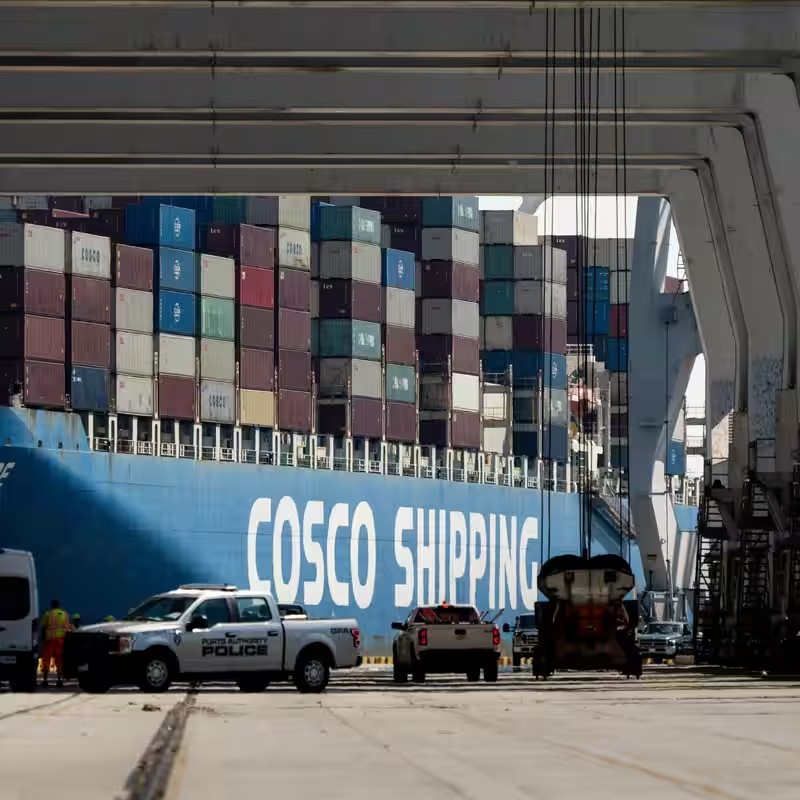In a bold move that reignites tensions in the U.S.-China trade rivalry, the Trump administration has begun charging fees on Chinese-built and Chinese-owned vessels docking at American ports—starting Tuesday, October 14, 2025. The policy, years in the making and originally launched under a Biden-era trade probe, is explicitly designed to counter China’s overwhelming dominance in global shipbuilding and jumpstart America’s nearly dormant commercial shipyard industry.
What’s Behind the New Shipping Fees?
The U.S. government argues that China has used massive state subsidies to flood the global market with cheap, high-quality ships—giving Chinese shipbuilders an unfair edge. American shipyards, by contrast, struggle to compete: a single large commercial vessel can cost up to five times more in the U.S. than in China.
According to BRS Shipbrokers, China built 717 large commercial ships in 2025 alone—while the U.S. managed just one. In 2024, China accounted for 60% of the world’s large vessel production, up from 44% in 2019.
Who Pays the New Fees?
The rules are layered but clear:
- Chinese shipping companies (like COSCO) must pay fees on every U.S. port call—no exceptions.
- Non-Chinese carriers (e.g., MSC, Maersk) must pay if they deploy Chinese-built ships to U.S. ports.
- Car carriers and LNG tankers of foreign origin are also subject to fees, with limited carve-outs.
Shipping firms are already rerouting fleets to avoid the levies. “Vessel owners and operators are adjusting fleet deployments to mitigate the impact,” said Utsav Mathur, a shipping law partner at Norton Rose Fulbright.
China Fires Back—Fast
Beijing didn’t wait long to retaliate. On Friday, China’s Ministry of Transport announced it would impose reciprocal fees on American vessels docking in Chinese ports. It also launched a formal investigation into entities allegedly aiding U.S. anti-China shipping policies.
In a more targeted strike, China added five U.S.-based subsidiaries of South Korea’s Hanwha Group to its sanctions list—accusing them of “supporting and assisting” America’s shipbuilding revival efforts. Hanwha Ocean’s shares dropped 8% immediately.
Economic Ripple Effects
While shipping lines claim they won’t pass costs to customers, economists are skeptical. “The inefficiencies, along with whatever fees are paid, will raise costs,” warned Colin Grabow of the Cato Institute. “It’s just a matter of when.”
HSBC estimates COSCO could face $1.5 billion in annual fees—potentially slashing its 2026 operating earnings by 75%.
Will This Revive U.S. Shipyards?
Supporters say every bit helps. “Anything we can do to chip away at the disparity in shipbuilding… is to our benefit,” said Mihir Torsekar of the Coalition for a Prosperous America.
There are glimmers of activity: Hanwha’s Philadelphia shipyard recently secured an order for 10 oil and chemical tankers—though critics note it’s an intra-company deal, not a market-driven revival.
Meanwhile, bipartisan legislation offering shipbuilding subsidies remains stalled in Congress.
U.S. vs. China Shipbuilding: By the Numbers
| Metric | China (2025) | United States (2025) |
|---|---|---|
| Large Commercial Ships Built | 717 | 1 |
| Global Market Share | 60% | <1% |
| Avg. Cost of Large Vessel | $80–100 million | $400–500 million |
| Major Shipyards | Over 100 active | Fewer than 10 commercial |
What’s Next?
The shipping fees coincide with new U.S. tariffs on furniture, cabinets, and lumber—signaling a broader trade strategy ahead of the 2026 midterms. Yet doubts remain: will penalizing Chinese ships actually bring work back to American docks, or just make global supply chains more expensive and fragmented?
One thing is certain: the battle for maritime supremacy has just entered a new, costly chapter.
Sources
The New York Times: U.S. Starts Charging Chinese Ships to Dock at Its Ports




